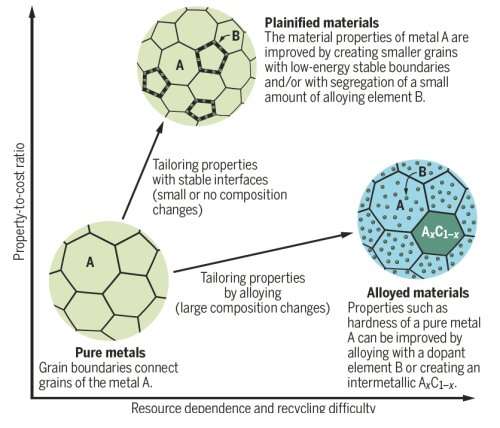Plainification holds promise for improving material sustainability

Extensive alloying makes material development more dependent on scarce resources. Alloyed materials with complicated compositions are also difficult to synthesize and recycle. With increased alloying, material costs continue to spiral while property enhancements level off. For these reasons, the sustainability of materials, especially metals, has recently gained more and more attention.
In a study published in Science, Prof. Li Xiuyan and Prof. Lu Ke from the Shenyang National Laboratory for Materials Science (SYNL), Institute of Metal Research of the Chinese Academy of Sciences propose improving material properties by plainification, a method of tailoring stable interfaces between grains at different length scales by using fewer or no alloying elements.
Plainification would advance material sustainability by lowering the cost of materials, increasing resource independence and improving material recyclability.
While the underlying principle of plainification is sound, it faces challenges due to the intrinsic instability of microstructures at the nanometer scale where property variations are dramatically increased.
Previous studies by Prof. Li Xiuyan and Prof. Lu Ke, published respectively in Science in 2018 and Phys. Rev. Lett. in 2019, revealed that nano-sized grains in pure copper and nickel produced from plastic deformation exhibit notable thermal and mechanical stability against coarsening below a critical grain size, thanks to an autonomous grain boundary relaxation to low-energy states that suppresses dislocation nucleation. Such stabilization strengthens metals in a way that is distinct from how alloys resist dislocation slip.
This finding offers new possibilities for developing stable nanostructured metals and alloys with novel properties, which is the basis for the plainification strategy.
As chief scientist, Prof. Li Xiuyan leads the Key R&D Project on "Plainification of materials with low-energy interfaces," which has been financially supported by the Ministry of Science and Technology (MOST) since 2018.
More information: Xiuyan Li et al, Improving sustainability with simpler alloys, Science (2019). DOI: 10.1126/science.aaw9905
Journal information: Science , Physical Review Letters
Provided by Chinese Academy of Sciences

















